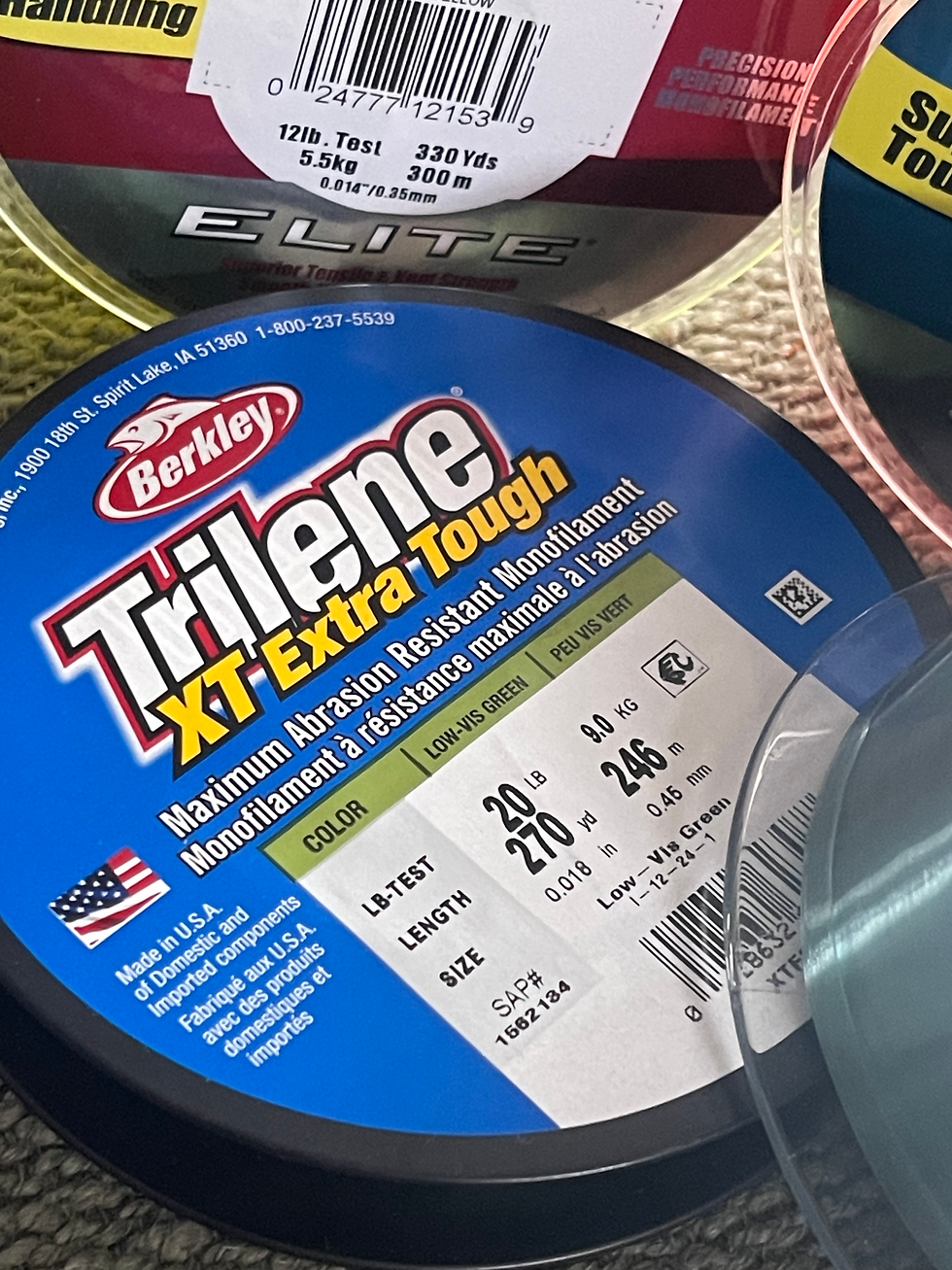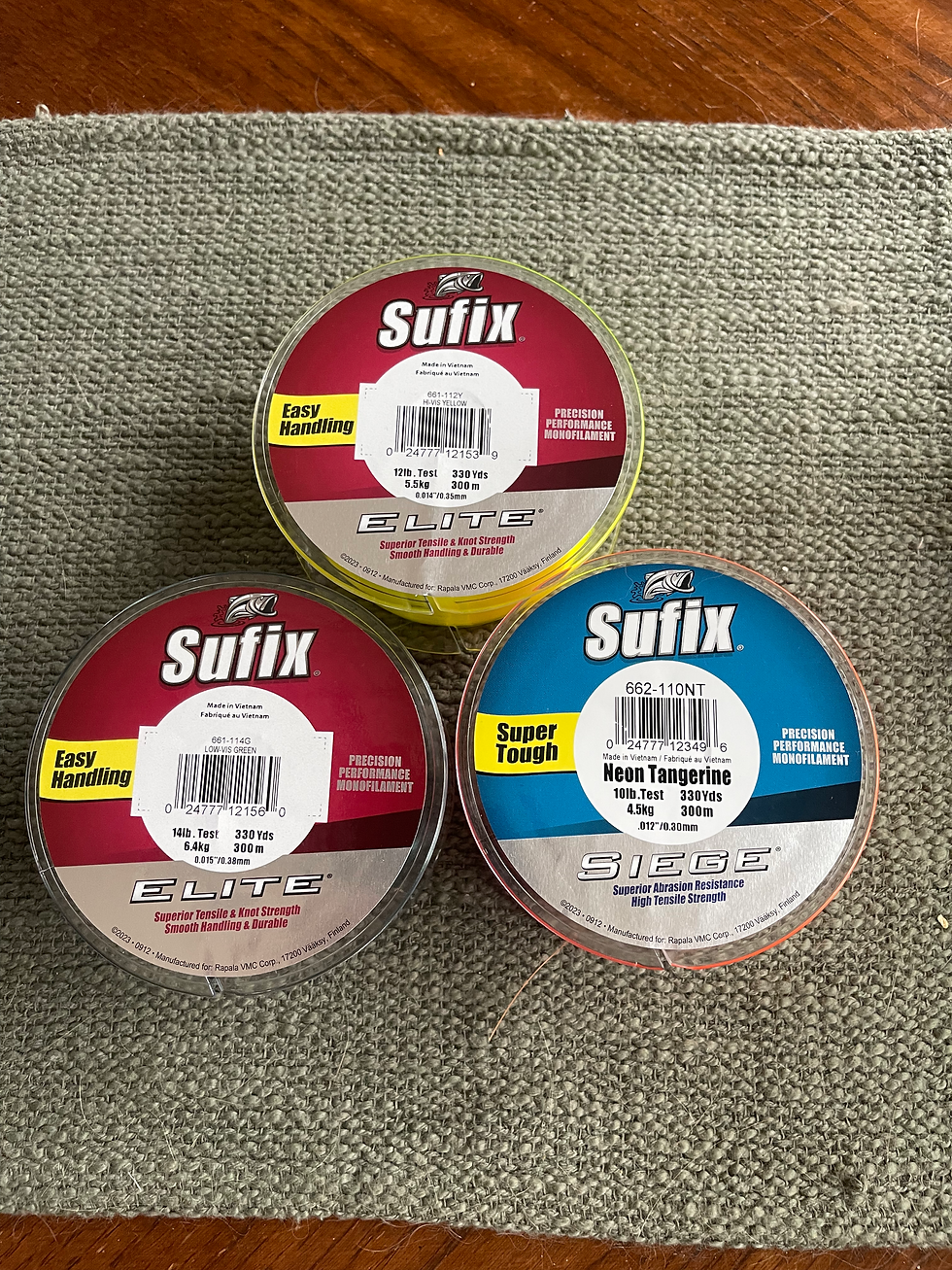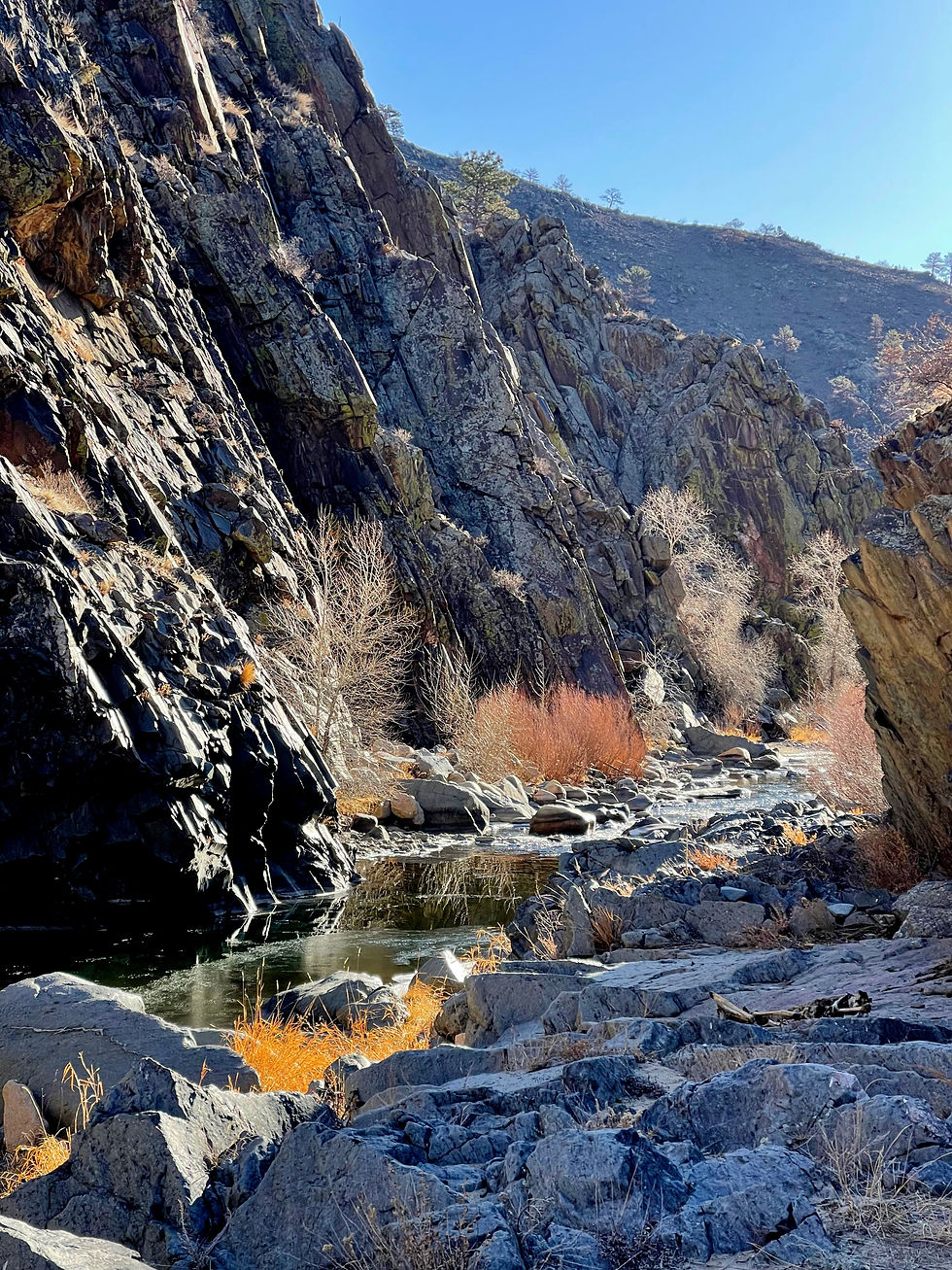The Tight Line Advantage
- flyingtroutco
- Apr 28
- 9 min read
I settled on fly fishing because of some inherent advantages over gear tackle that I really valued and enjoyed. This all started with fly line. The ability to cast fly line and meat fish on their terms was different then what I had experienced with spin tackle or bait casting. I love the feeling of casting a fly line and I truly think it allows an angler to present the fly in a more natural way, and provides access to a different sense of versatility which only leads to more fish in the net.

However, recently fly line, or rather leaders have seemed to limit my experience on the water. Despite good casting fundamentals I felt the flimsy nature of the store bought leaders was leading to less strike detection, reduced accuracy, and limited what I could do on the water. As I read and listened to many sources in the flyfishing community I kept hearing about this “monorig” system. Essentially this system uses a very long leader (30 feet +) but it is tied with thicker material than is usually used in fly fishing leaders. The result is a system that casts like a fly line but gives you the added benefits of better strike detection, more accuracy, and more versatility. I don’t know about you, but that sounds a little too good to be true - I decided to give it a shot.
In my first day of fishing with this new system the advantages became very clear very quickly. I started the day with nymphing as I usually do. My new long leader ended at a tippet ring that I could easily attach some 5x tippet to. I secured two flies to the system and laid my first cast. I was instantly shocked by the turnover I could still get through the cast and after a few I was easily tucking the fly exactly where I wanted it to be. The leader was long enough my fly line could stay completely inside the reel, my line hand was holding on to monofilament, at first this felt weird but as my flies drifted through a seam I I could feel everything that was going in with that fly, I could feel it drop in the water column, I could feel it tick the bottom, and when a fish took the fly, the feedback was instant even with extremely subtle takes. I was shocked with how much feedback I was getting.
The morning progressed and soon I started seeing subtle eats on the surface of the water. The trout were eating small midges hatching off the smooth sections of water. I quickly snipped off my nymphs and tied on a small midge dry fly. I was nervous for how well this system would present small dry flies, it didn’t seem like it would have enough power to truly push that small fly out where I would need it. My first cast wasn’t what I wanted, but after making a few adjustments and focusing on good, solid casting fundamentals my fly was able to get out just as far as if I had used my weighted fly line. I also noticed significantly less drag than what I expect from a fly line. When using dries I typically mend my fly line more than a few times as the fly drifts through the seam or pool. That simply wasn’t needed in this case. The light line stayed in contact with the fly and I could easily pick up the line, leaving the dry fly completely untouched, to adjust the line as needed.
I picked up a few fish on those dries and the action started to slow. Finally I tied on a streamer to round out the end of my day and cast toward an undercut cliff. I thought this system would do well with streamers because they require the least delicate casts. Casting was easy but what I did not expect was how much control I had over the fly. I was able to control the streamer in ways I was not used to. I could flip the head of the fly, change direction, raise or lower the fly in the column. Overall I had far more control over the system then I had expected and as a result I was able to finish my day with a few more fish on those streamers.
As I drove home that day, twisting and turning through a winding mountain road, I reflected on how much I was able to accomplish with high level presentations. In a typical day a fly angler has a few choices to make, they can either commit to one style, nymphs, dries, or streamers, or they can switch leader/tippet material throughout the day to match the situation (I typically find myself in this camp), or they can retain the same line for each type and deal with the disadvantage of their line size and type (nylon or fluro for example). None of these options is great but we are forced to make these decisions to be effective on the water. I have always leaned toward efficiency and this system offered me a new landscape of efficiency, by simply clipping some tippet at a tippet ring I was able to switch to completely different methods of fishing and give excellent presentations in each. In the next few paragraphs I will outline this system, how I tied it up, and how you can use it. This will be a very entry level introduction to the tight line system, hopefully in future articles we will explore the further specifics of this system and methods.

The Build
One of the first advantages of this system is that you are essentially buying monofilament line in bulk and tying sizes together. A quick investment in a few 300 yard spools easily gives you enough supply for a large amount of leaders. There is a TON of information and opinions on what materials and brands to use specifically, as a beginner tight line guy, I truly don’t have enough experience to speak on those materials so I will simply outline what I used after researching for a few days and what worked for me.
The system is built of a butt section connected to your fly line, a body section meant to build in your taper and transfer power, the body is connected to a tippet ring which then leads to a tippet section. The wonderful thing about this system is as you practice and play with it you can adjust it to your needs and wants out of your fishing.

Butt section
The butt section is made of 20 feet of 20 lb monofilament, in my leaders I used Berkley Trilene extra tough. Color doesn’t really matter but I used the low-vis green figuring it would stand out the least if I was targeting spooky fish. A lot of people are partial to Amnesia line, I haven't used it yet, the store was out of the line at the time and I am impatient. But many people swear by the 20 lb version of this line and say that it is the best butt section material for self tied leaders.
I tie a 20 foot section of 20 lb mono into a simple perfection loop which I can easily attach to my fly line with a loop to loop connection. This only adds to the versatility of the system, if I want to switch to a shorter leader, I simply disconnect the loop connection and reconnect with a different leader. This adds versatility to the system. The other key here is power, this is the portion of the leader that we will be casting so we want plenty of power built into the system so we can get good turnover even with the smallest flies.

Body Section
This is where we will build the transfer of power. To do this we tie in some taper by reducing the size of the line in three increments. For all of these sections throughout the body I used Sufix monofilament. First I tied 3 feet of 14 lb mono directly to my butt section using a double surgeon's knot. I liked the lo-vis green but any color would be fine here. Then I followed this with 2 feet of 12lb mono, I used the high vis yellow color to build in some sighting and make the line easier to track. Finishing the body I used 1 foot of 10lb mono in the neon tangerine color. This last section is tied off to a tippet ring that will lead to the tippet section.
There are a few things I really liked with the way I built this section. First, the taper in line size and the length of each of those sections helped build in a strong taper which provided better turnover then when I tried the same formula keeping them all 2 feet sections through the taper. Second, the color of the line through the last two sections helps build a slighter that is easy to see and track where the line is whether we are in contact or letting the line float on the surface of the water.
Tippet section
The tippet section is where I can customize the presentation for what I am pursuing in the moment. That tippet ring makes it easier to switch between tippet sizes and material. For example if I am fishing nymphs I like fluorocarbon tippet, but when dry flies start popping off the surface I can easily snip the tippet at the tippet ring and add nylon tippet for a better float.
This section begins with a tippet ring, I like the smallest possible because I want it to be as light as possible. This way when I am in touch with the fly I get as little sag in the line as possible. I simply use a clinch knot to secure the body section to the ring, then I use the same knot to secure the tippet. The beauty of this design is that it is completely customizable to the fly you are using. I like to use fluorocarbon for nymphs and streamers but I use nylon for dry fly presentation because it floats better. The tippet ring connection makes switching between these seamless. I can even keep flies rigged to tippet so when I want to make a switch all I have to do is tie that tippet section back to the tippet ring with that clinch knot and I am off. This worked really well on full days on the water where I switch between nymphs, dries, and streamers throughout the day. This way I can meet the trout on their terms and always have the best presentation possible. Below I will outline my go to combination of tippet for each fly type.
Dries
Tippet ring
12” : 2x nylon
12” : 4x nylon
Fly
Nymphs
Tippet ring
12” : 2x Bi color fluro
12” : 4x fluro
(OPTIONAL: 6x fluro if the fish are being really picky)
Fly
Streamers
Tippet ring
12” : 2x fluro
12” : 3x fluro
Fly
Bringing it all Together
The greatest advantage of fly fishing is versatility, and more often than not it is the versatile angler who wins the day. We have to be prepared for all situations on the water and we have to be able to meet fish on their terms. Otherwise we might as well all use gear tackle, throw powerbait as far as we can and wait for what happens,I am sure our lives would be a lot easier. But I don’t want it easy, I want to put fish in the net. If you're sitting there reading this and thinking to yourself “Jesus, do we really have to make fishing more complicated?”, believe me I get it. When I first heard of the mono-rig system I scoffed too, thinking “I will take my fly line over self lied leaders any day”. But eventually curiosity got the best of me and the results spoke for themselves. The versatility, customization, and ability to change quickly and efficiently are unmatched by anything else I have seen in fly fishing, except maybe switching from rod to rod, but carrying three rods is filled with hardships and compromise as well. I would urge you to give it a shot, just give it one chance. But it has to be a fair chance. Tie a leader and take it out for a whole day, If you like fly line more than great! The beauty of this system is you can switch back and forth from mono to fly line if you want.

I don’t think anything will truly replace fly line in my heart. I still love and cherish the feel of casting fly lines and pushing my line across water. However when it comes time to meet trout on their terms, to pick a stream apart and find every corner the fish are hiding, my hand will reach for the monorig where I will find the tightline advantage. With this tool you can switch in and out of contact, you can drift dries, you can high stick nymphs, and you can strip streamers all within minutes of each other. This is the meaning of true versatility, finding and meeting trout on their terms, and presenting whatever food source they may be keying in on. Switching with speed and casting with accuracy. True efficiency, ultimate versatility, and more time catching fish, that is the tightline advantage.
I hope this article helps introduce you to the world of the monorig. As always if you have any questions or new ideas please leave a comment or send an email, your input is always welcome. Below you will find the basic formula I have used for my mono rig. Use it or make your own and let us know what you think!
The Build
20 FT : 20lb mono : Low-vis green ( Trilene XT OR Red Amnesia)
3 FT : 14lb mono : Low-vis green : Sufix Elite
2 FT : 12lb mono : Hi-vis yellow : Sufix Elite
1 FT : 10lb mono : Neon tangerine : Sufix siege
Tippet Ring
Tippet section to match your fly selection!









Comments